Portraying Citizens’ Occupations and Assessing Urban Occupation Mixture with Mobile Phone Data: A Novel Spatiotemporal Analytical Framework
Abstract
:1. Introduction
2. Data and Methods
2.1. Study Area
2.2. Data
2.3. Pre-Processing of Mobile Phone Data
2.4. Processing of Extracting Employed Population
2.5. Processing of Portraying Citizens’ Occupations
- Financial practitioners:
- IT practitioners:
- Teachers:
- Wholesalers and sole traders:
- Express staff:
- Medical staff:
2.6. Assessing the Urban Occupation Mixture Index
2.7. Spatial Analysis Methods
3. Results and Discussion
3.1. Identification of Employed Population
3.2. Portraying Citizens’ Occupations
- Financial practitioners:
- Wholesalers and sole traders:
- IT practitioners:
- Express staff:
- Teachers:
- Medical staff:
3.3. Assessing Urban Occupation Mixture
4. Conclusions
Author Contributions
Funding
Conflicts of Interest
References
- Li, C.; Hu, J.; Dai, Z.; Fan, Z.; Wu, Z. Understanding Individual Mobility Pattern and Portrait Depiction Based on Mobile Phone Data. ISPRS Int. J. Geo-Inf. 2020, 9, 666. [Google Scholar] [CrossRef]
- Gan, T.; Li, W.; He, L.; Li, J. Intracity Pandemic Risk Evaluation Using Mobile Phone Data: The Case of Shanghai during COVID-19. ISPRS Int. J. Geo-Inf. 2020, 9, 715. [Google Scholar] [CrossRef]
- Willberg, E.; Järv, O.; Väisänen, T.; Toivonen, T. Escaping from Cities during the COVID-19 Crisis: Using Mobile Phone Data to Trace Mobility in Finland. ISPRS Int. J. Geo-Inf. 2021, 10, 103. [Google Scholar] [CrossRef]
- Chen, Q.; Hu, Z.; Su, H.; Tang, X.; Yu, K. Understanding travel patterns of tourists from mobile phone data: A case study in Hainan. In Proceedings of the 2018 IEEE International Conference on Big Data and Smart Computing (BigComp), Shanghai, China, 15–17 January 2018; Volume 1, pp. 45–51. [Google Scholar]
- Doyle, J.; Huang, P.; Farrell, R.; McLoone, S. Population mobility dynamics estimated from mobile telephony data. J. Urban Technol. 2014, 21, 109–132. [Google Scholar] [CrossRef]
- Manfredini, F.; Pucci, P.; Tagliolato, P. Toward a systemic use of manifold cell phone network data for urban analysis and planning. J. Urban Technol. 2014, 21, 39–59. [Google Scholar] [CrossRef]
- Niu, X.; Yue, Y.; Zhou, X.; Zhang, X. How Urban Factors Affect the Spatiotemporal Distribution of Infectious Diseases in Addition to Intercity Population Movement in China. ISPRS Int. J. Geo-Inf. 2020, 9, 615. [Google Scholar] [CrossRef]
- Chen, Y.; Liu, X.; Li, X.; Liu, X.; Yao, Y.; Hu, G.; Xu, X.; Pei, F. Delineating urban functional areas with building-level social media data: A dynamic time warping (DTW) distance based k-medoids method. Landsc. Urban Plan. 2017, 160, 48–60. [Google Scholar] [CrossRef]
- Cao, Z.; Wu, Z.; Li, S.; Guo, G.; Song, S.; Deng, Y.; Ma, W.; Sun, H.; Guan, W. Explicit Spatializing Heat-Exposure Risk and Local Associated Factors by Coupling Social Media Data and Automatic Meteorological Station Data. Environ. Res. 2020, 188, 109813. [Google Scholar] [CrossRef]
- Brown, A.; LaValle, W. Hailing a change: Comparing taxi and ridehail service quality in Los Angeles. Transportation 2021, 48, 1007–1031. [Google Scholar] [CrossRef]
- Yang, H.; Liang, Y.; Yang, L. Equitable? Exploring ridesourcing waiting time and its determinants. Transp. Res. Part D Transp. Environ. 2021, 93, 102774. [Google Scholar] [CrossRef]
- Li, C.; Wu, Z.; Zhu, L.; Liu, L.; Zhang, C. Changes of Spatiotemporal Pattern and Network Characteristic in Population Flow under COVID-19 Epidemic. ISPRS Int. J. Geo-Inf. 2021, 10, 145. [Google Scholar] [CrossRef]
- Gao, F.; Li, S.; Tan, Z.; Zhang, X.; Lai, Z.; Tan, Z. How Is Urban Greenness Spatially Associated with Dockless Bike Sharing Usage on Weekdays, Weekends, and Holidays? ISPRS Int. J. Geo-Inf. 2021, 10, 238. [Google Scholar] [CrossRef]
- Gao, F.; Li, S.; Tan, Z.; Wu, Z.; Zhang, X.; Huang, G.; Huang, Z. Understanding the modifiable areal unit problem in dockless bike sharing usage and exploring the interactive effects of built environment factors. Int. J. Geogr. Inf. Sci. 2021, 35, 1–21. [Google Scholar] [CrossRef]
- Li, S.; Zhuang, C.; Tan, Z.; Gao, F.; Lai, Z.; Wu, Z. Inferring the trip purposes and uncovering spatio-temporal activity patterns from dockless shared bike dataset in Shenzhen, China. J. Transp. Geogr. 2021, 91, 102974. [Google Scholar] [CrossRef]
- Li, S.; Lyu, D.; Liu, X.; Tan, Z.; Gao, F.; Huang, G.; Wu, Z. The varying patterns of rail transit ridership and their relationships with fine-scale built environment factors: Big data analytics from Guangzhou. Cities 2020, 99, 102580. [Google Scholar] [CrossRef]
- Li, S.; Lyu, D.; Huang, G.; Zhang, X.; Gao, F.; Chen, Y.; Liu, X. Spatially varying impacts of built environment factors on rail transit ridership at station level: A case study in Guangzhou, China. J. Transp. Geogr. 2020, 82, 102631. [Google Scholar] [CrossRef]
- Tu, Z.; Cao, H.; Lagerspetz, E.; Fan, Y.; Flores, H.; Tarkoma, S.; Nurmi, P.; Li, Y. Demographics of mobile app usage: Long-term analysis of mobile app usage. CCF Trans. Pervasive Comput. Interact. 2021, 5. [Google Scholar] [CrossRef]
- Peltonen, E.; Lagerspetz, E.; Hamberg, J.; Mehrotra, A.; Musolesi, M.; Nurmi, P.; Tarkoma, S. The hidden image of mobile apps: Geographic, demographic, and cultural factors in mobile usage. In Proceedings of the 20th International Conference on Human-Computer Interaction with Mobile Devices and Services, ACM, MobileHCI ’18, New York, NY, USA, 3–6 September 2018. [Google Scholar] [CrossRef]
- Kumar, P.; Gowlikar, D. Analysis of Mobile App Usage Preferences of University Students in Eastern Bhutan; Elsevier: Amsterdam, The Netherlands, 2021. [Google Scholar] [CrossRef]
- Malmi, E.; Weber, I. You Are What Apps You Use: Demographic Prediction Based on User’s Apps. In Proceedings of the International AAAI Conference on Web and Social Media, ICWSM, Cologne, Germany, 17–20 May 2016. [Google Scholar]
- Ernsting, C.; Dombrowski, S.; Šteko, M.; O’Sullivan, J.; Kanzler, M.; Kuhlmey, A.; Gellert, P. Using Smartphones and Health Apps to Change and Manage Health Behaviors: A Population-Based Survey. J. Med. Internet Res. 2017, 19, e101. [Google Scholar] [CrossRef] [PubMed]
- Zhou, X.; Yeh, A.G.O. Understanding the modifiable areal unit problem and identifying appropriate spatial unit in jobs–housing balance and employment self-containment using big data. Transportation 2020. [Google Scholar] [CrossRef]
- Zhou, X.; Yeh, A.G.O.; Yue, Y. Spatial variation of self-containment and jobs-housing balance in Shenzhen using cellphone big data. J. Transp. Geogr. 2018, 68, 102–108. [Google Scholar] [CrossRef]
- Qian, C.; Li, W.; Duan, Z.; Yang, D.; Ran, B. Using mobile phone data to determine spatial correlations between tourism facilities. J. Transp. Geogr. 2021, 92, 103018. [Google Scholar] [CrossRef]
- Guo, H.; Li, W.; Yao, F.; Wu, J.; Zhou, X.; Yue, Y.; Yeh, A.G.O. Who are more exposed to PM2.5 pollution: A mobile phone data approach. Environ. Int. 2020, 143, 105821. [Google Scholar] [CrossRef] [PubMed]
- Lee, K.-S.; You, S.Y.; Eom, J.K.; Song, J.; Min, J.H. Urban spatiotemporal analysis using mobile phone data: Case study of medium- and large-sized Korean cities. Habitat Int. 2018, 73, 6–15. [Google Scholar] [CrossRef]
- Louail, T.; Lenormand, M.; Picornell, M.; Cantú, O.G.; Herranz, R.; Frias-Martinez, E.; Ramasco, J.J.; Barthelemy, M. Uncovering the spatial structure of mobility networks. Nat. Commun. 2015, 6, 6007. [Google Scholar] [CrossRef] [PubMed] [Green Version]
- Gong, L.; Jin, M.; Liu, Q.; Gong, Y.; Liu, Y. Identifying Urban Residents’ Activity Space at Multiple Geographic Scales Using Mobile Phone Data. ISPRS Int. J. Geo-Inf. 2020, 9, 241. [Google Scholar] [CrossRef]
- Gao, S. Spatio-Temporal Analytics for Exploring Human Mobility Patterns and Urban Dynamics in the Mobile Age. Spat. Cogn. Comput. Interdiscip. J. 2015, 15, 86–114. [Google Scholar] [CrossRef]
- Yin, L.; Lin, N.; Zhao, Z. Mining Daily Activity Chains from Large-Scale Mobile Phone Location Data. Cities 2021, 109, 103013. [Google Scholar] [CrossRef]
- Cao, J.; Li, Q.; Tu, W.; Gao, Q.; Cao, R.; Zhong, C. Resolving urban mobility networks from individual travel graphs using massive-scale mobile phone tracking data. Cities 2021, 110, 103077. [Google Scholar] [CrossRef]
- Jiang, S.; Ferreira, J.; González, M. Clustering daily patterns of human activities in the city. Data Min. Knowl. Discov. 2012, 25, 478–510. [Google Scholar] [CrossRef] [Green Version]
- Ding, D.; Mao, H.; Lu, Z. Research on population type recognition based on mobile signaling data. In Proceedings of the 14th China Intelligent Transportation Conference, Qingdao, China, 31 October 2019; pp. 417–428. [Google Scholar]
- Tu, W.; Cao, J.; Yue, Y.; Shaw, S.; Zhou, M.; Wang, Z.; Chang, X.; Xu, Y.; Li, Q. Coupling mobile phone and social media data: A new approach to understanding urban functions and diurnal patterns. Int. J. Geogr. Inf. Sci. 2017, 31, 2331–2358. [Google Scholar] [CrossRef]
- Liu, K.; Murayama, Y.; Ichinose, T. Exploring the relationship between functional urban polycentricity and the regional characteristics of human mobility: A multi-view analysis in the Tokyo metropolitan area. Cities 2021, 111, 103109. [Google Scholar] [CrossRef]
- Zhou, X.; Yeh, A.; Li, W.; Yue, Y. A commuting spectrum analysis of the jobs–housing balance and self-containment of employment with mobile phone location big data. Environ. Plan. B 2018. [Google Scholar] [CrossRef]
- Shannon, C.E. A mathematical theory of communication. Bell Syst. Tech. J. 1948. [Google Scholar] [CrossRef] [Green Version]
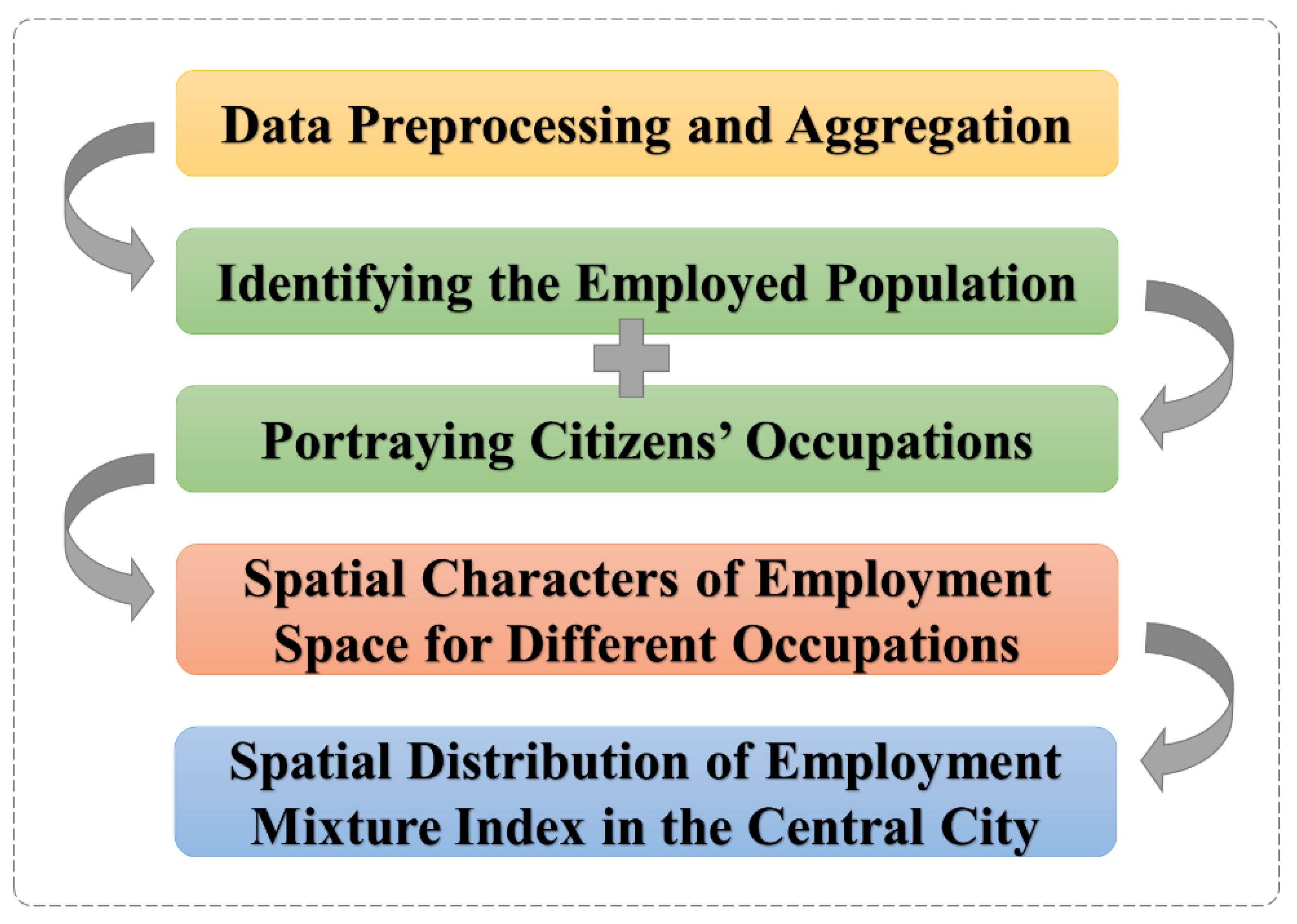

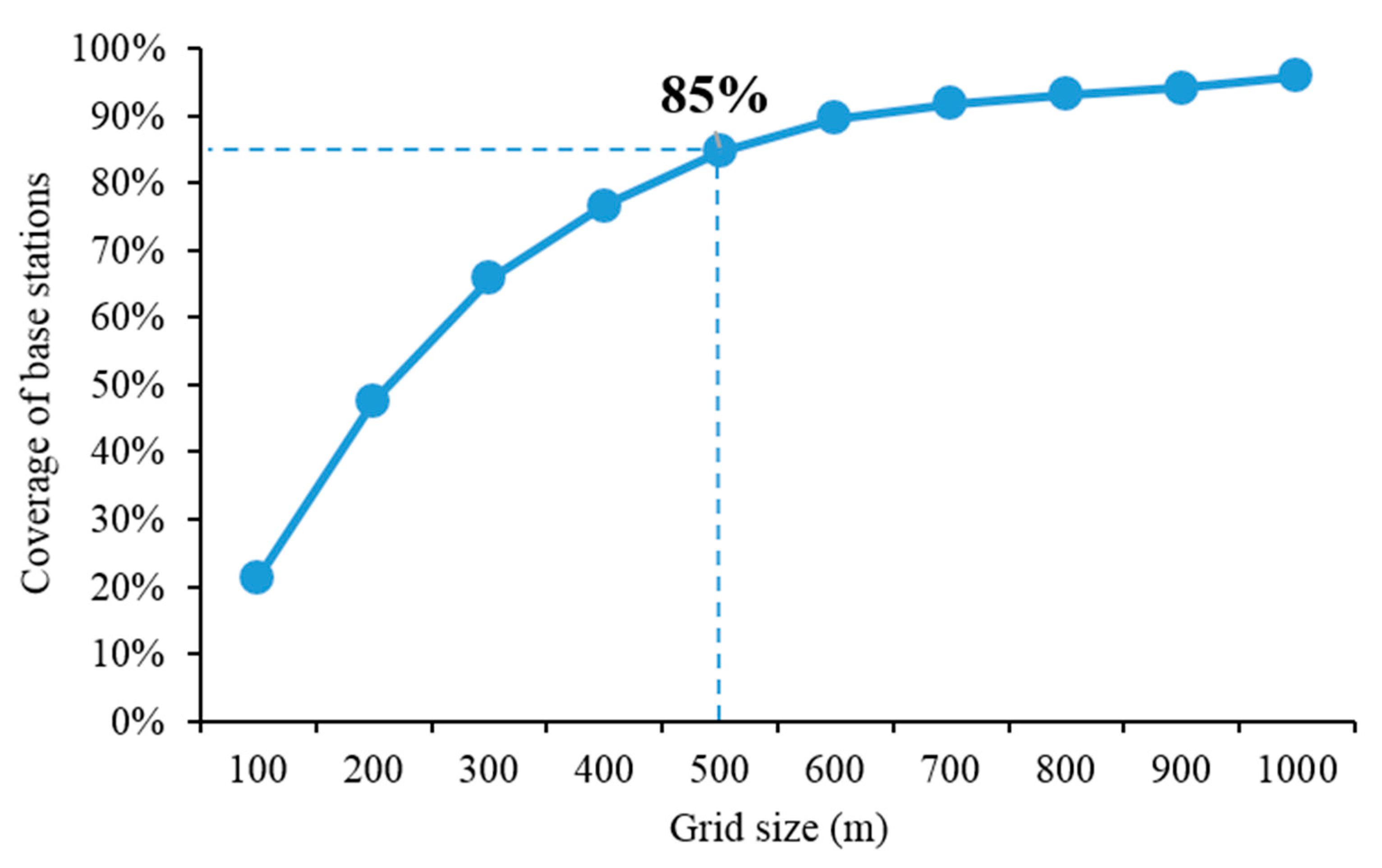

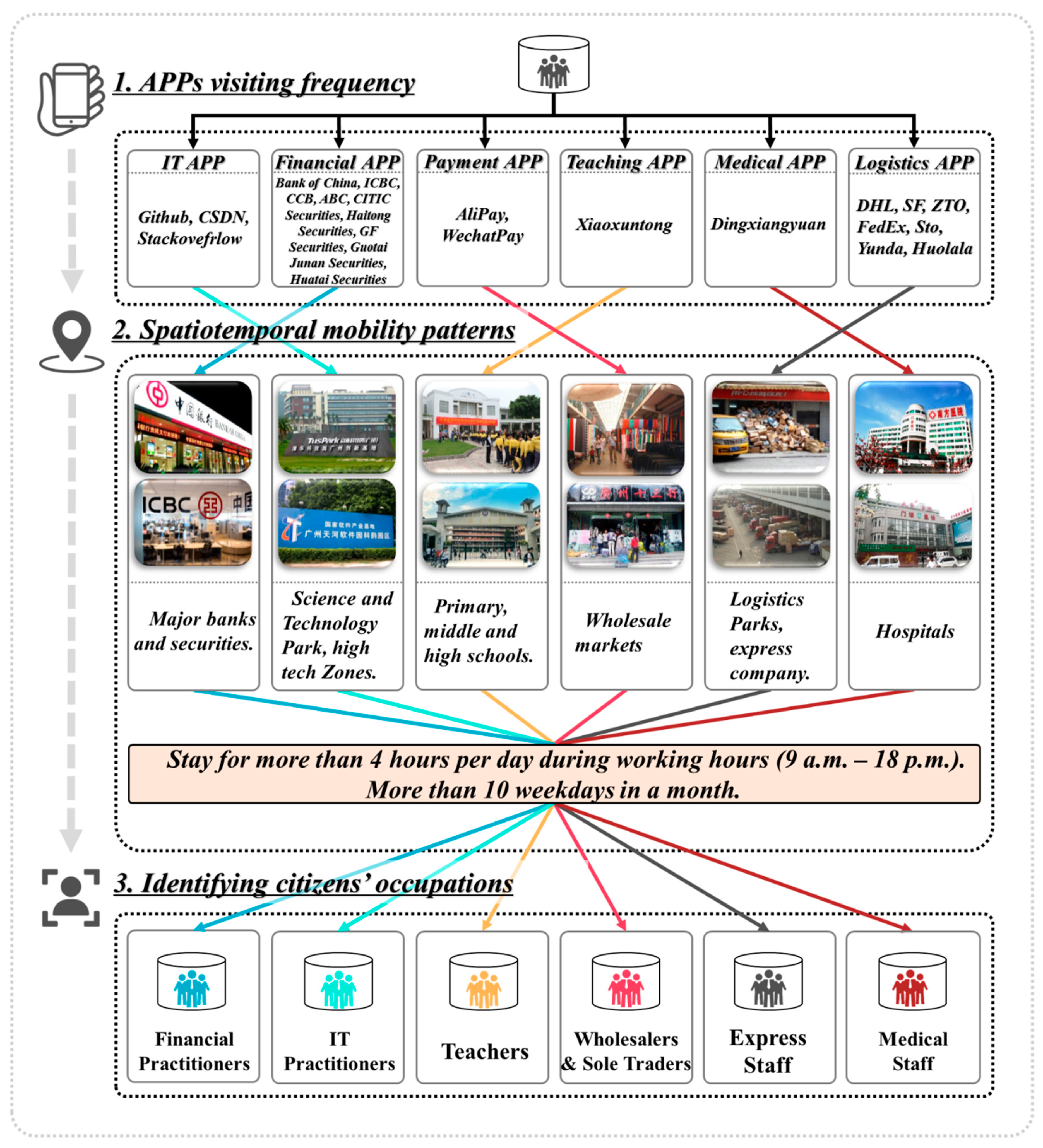

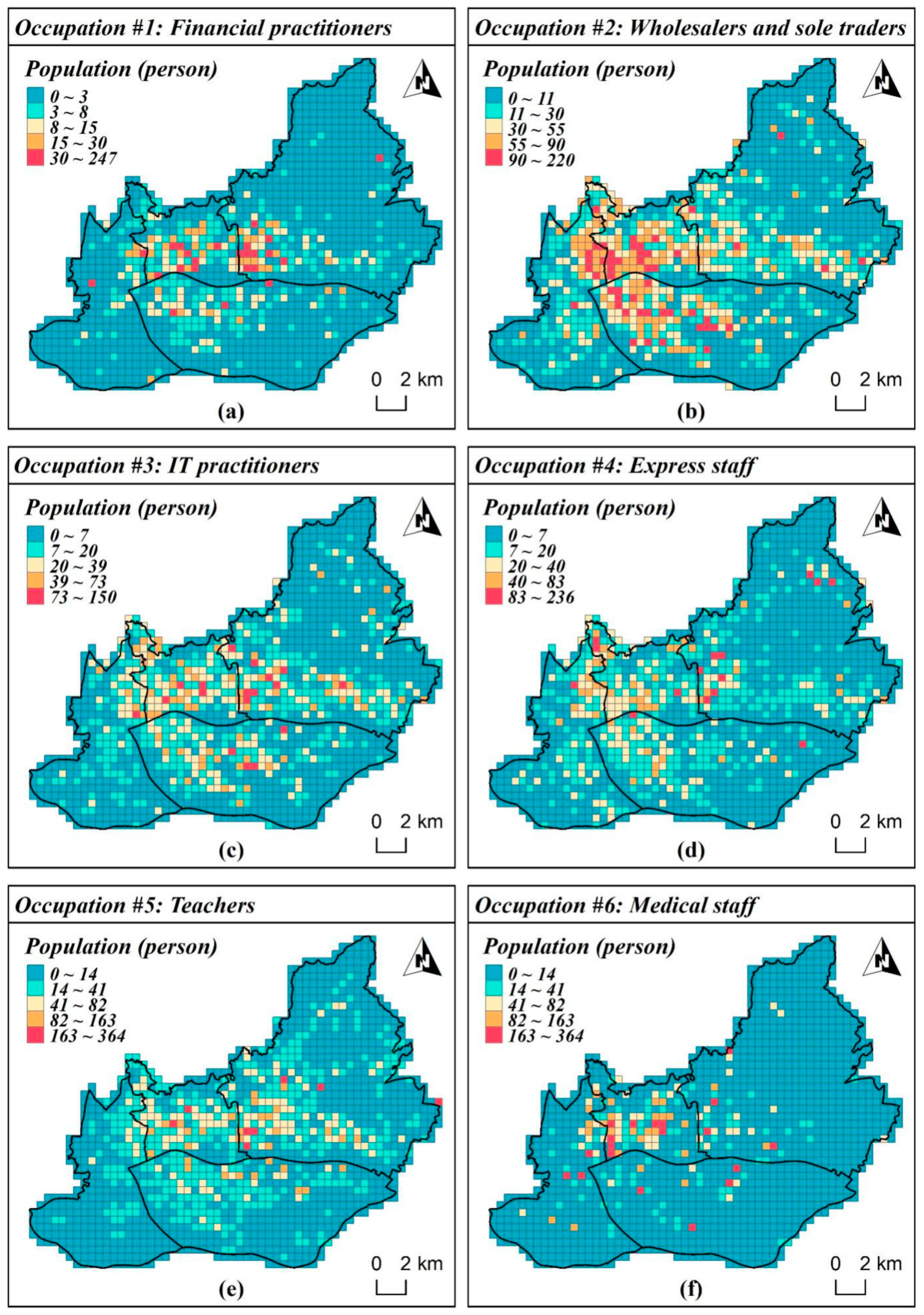
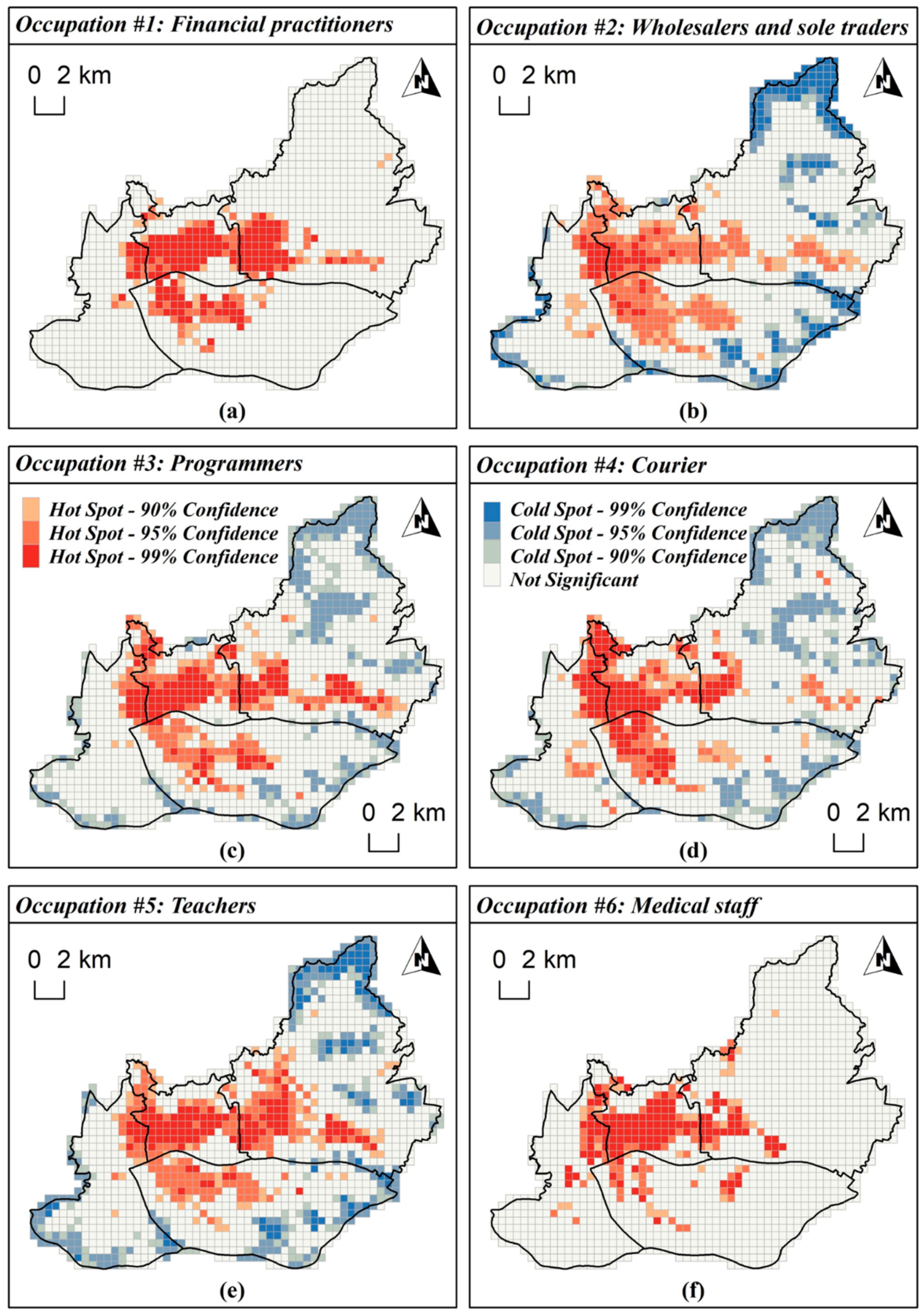
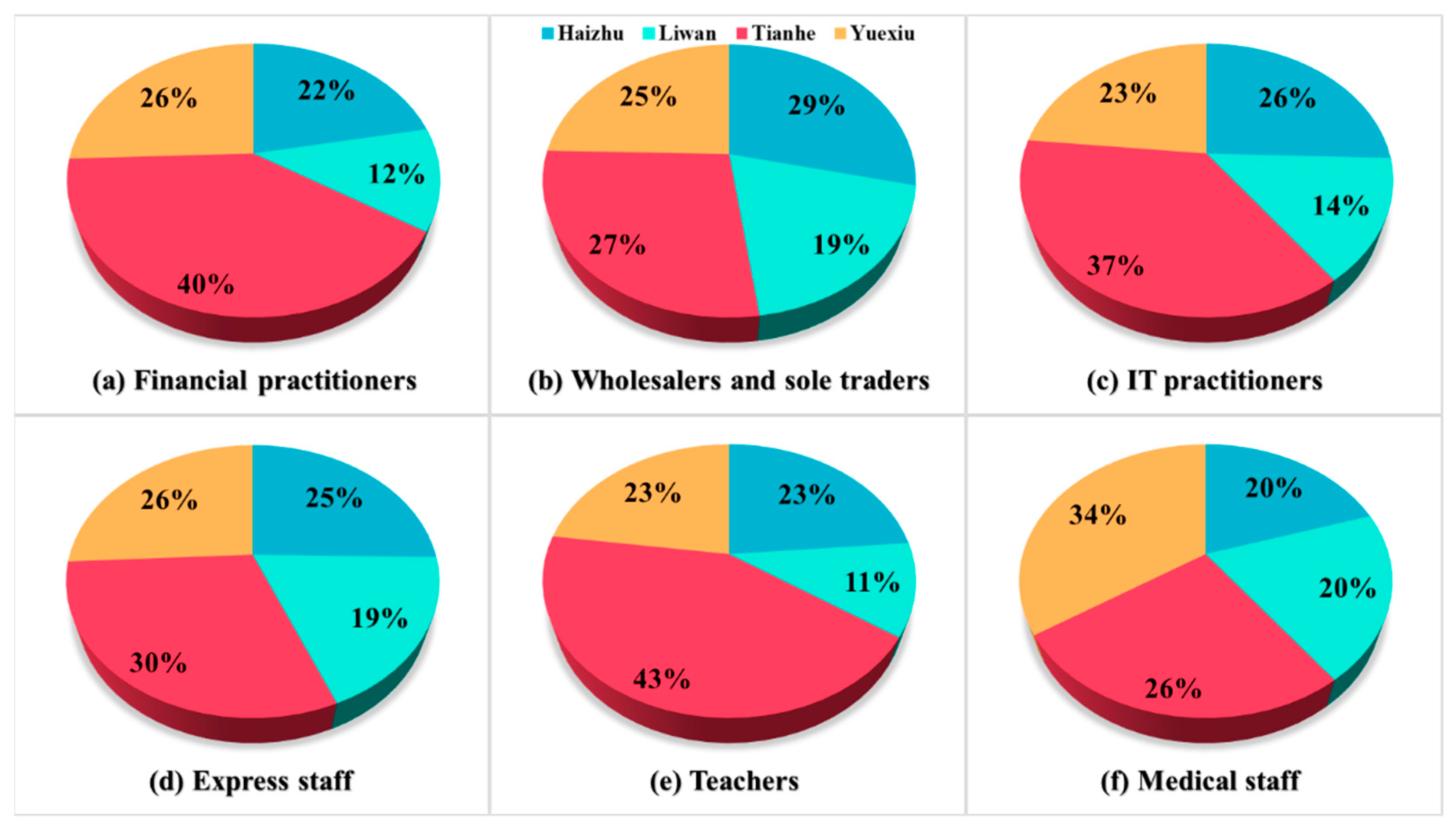
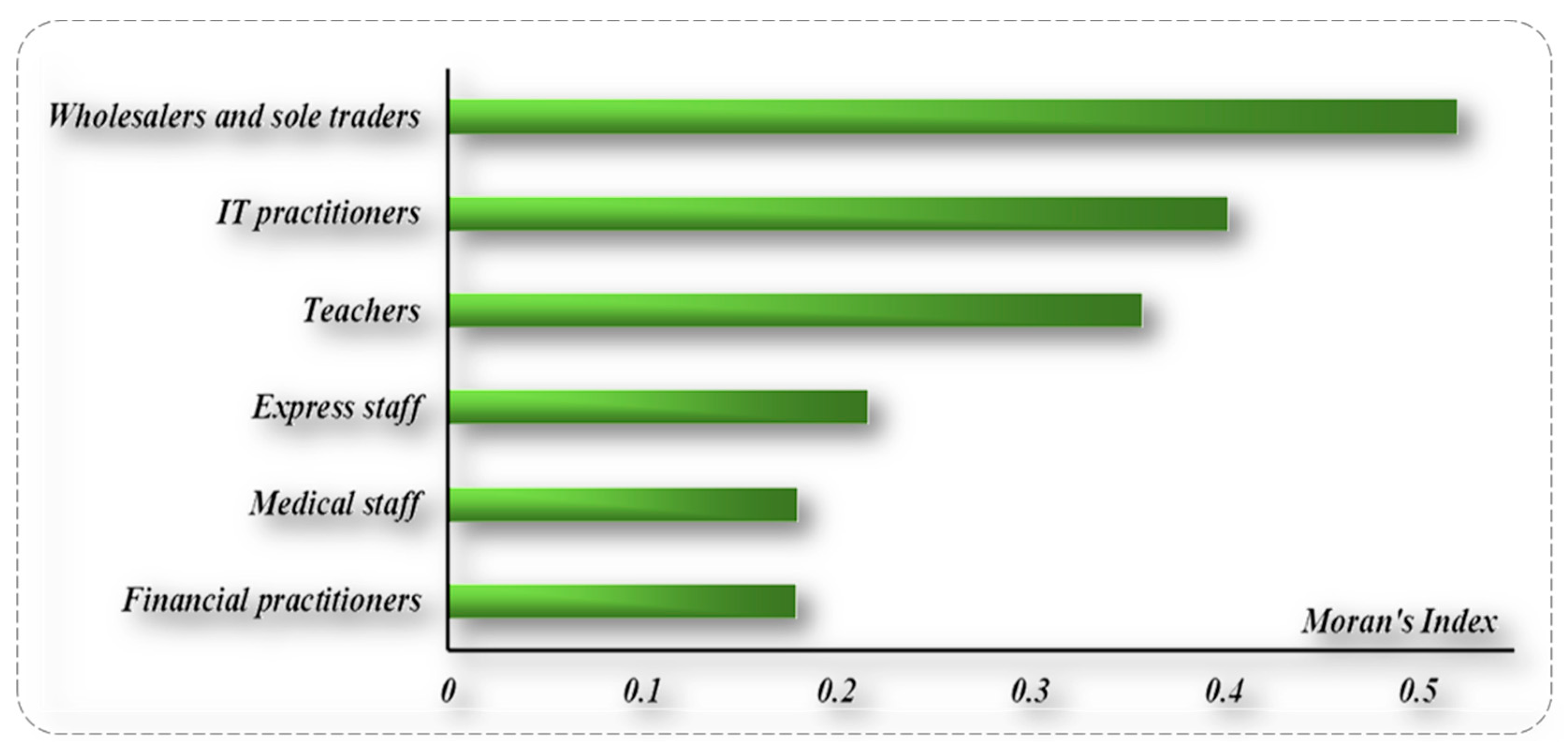
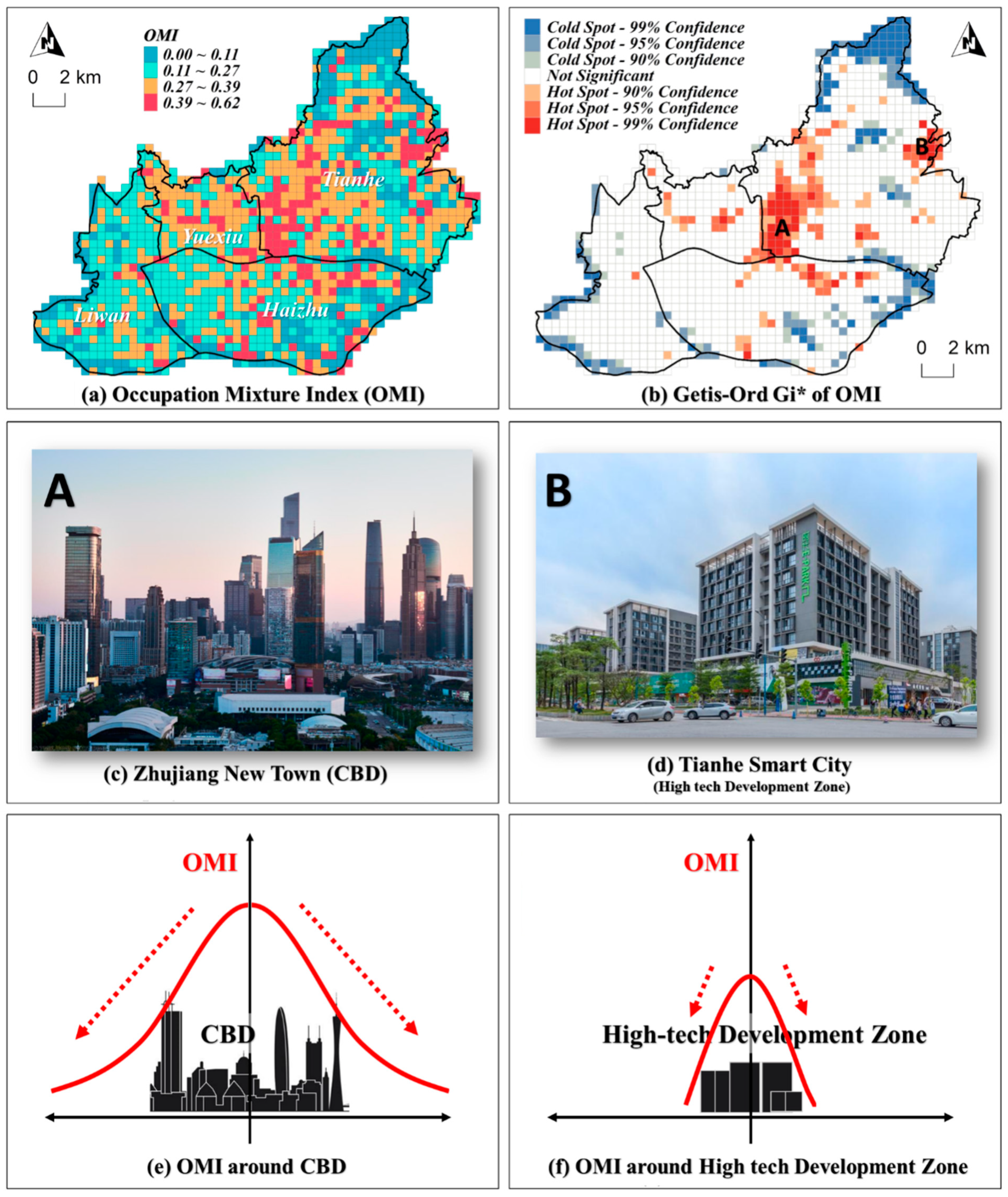
Publisher’s Note: MDPI stays neutral with regard to jurisdictional claims in published maps and institutional affiliations. |
© 2021 by the authors. Licensee MDPI, Basel, Switzerland. This article is an open access article distributed under the terms and conditions of the Creative Commons Attribution (CC BY) license (https://creativecommons.org/licenses/by/4.0/).
Share and Cite
Zhang, X.; Gao, F.; Liao, S.; Zhou, F.; Cai, G.; Li, S. Portraying Citizens’ Occupations and Assessing Urban Occupation Mixture with Mobile Phone Data: A Novel Spatiotemporal Analytical Framework. ISPRS Int. J. Geo-Inf. 2021, 10, 392. https://doi.org/10.3390/ijgi10060392
Zhang X, Gao F, Liao S, Zhou F, Cai G, Li S. Portraying Citizens’ Occupations and Assessing Urban Occupation Mixture with Mobile Phone Data: A Novel Spatiotemporal Analytical Framework. ISPRS International Journal of Geo-Information. 2021; 10(6):392. https://doi.org/10.3390/ijgi10060392
Chicago/Turabian StyleZhang, Xiaoming, Feng Gao, Shunyi Liao, Fan Zhou, Guanfang Cai, and Shaoying Li. 2021. "Portraying Citizens’ Occupations and Assessing Urban Occupation Mixture with Mobile Phone Data: A Novel Spatiotemporal Analytical Framework" ISPRS International Journal of Geo-Information 10, no. 6: 392. https://doi.org/10.3390/ijgi10060392
APA StyleZhang, X., Gao, F., Liao, S., Zhou, F., Cai, G., & Li, S. (2021). Portraying Citizens’ Occupations and Assessing Urban Occupation Mixture with Mobile Phone Data: A Novel Spatiotemporal Analytical Framework. ISPRS International Journal of Geo-Information, 10(6), 392. https://doi.org/10.3390/ijgi10060392




